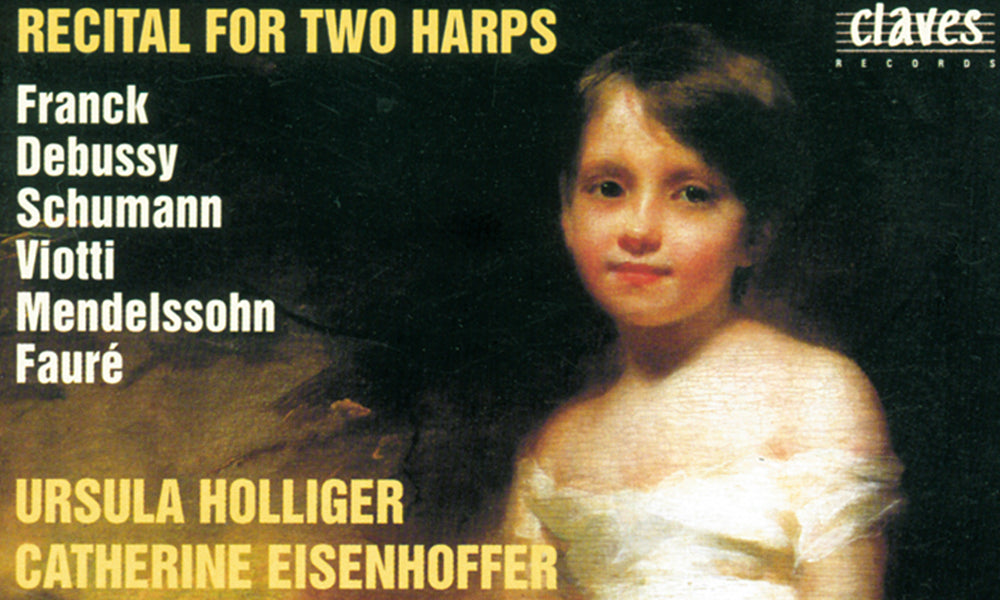
Audiophile Audition: Recital for Two Harps – Ursula Holliger & Catherine Eisenhoffer, harps
There’s a sadness about this album. Partly it’s the somewhat melancholy sound of the harp – here doubled. But also it’s the realization that the lead performer, Ursula Holliger, died last year so we will not be hearing her play again. Ursula was the wife of renowned oboist Heinz Holliger and they both played central roles in the musical life of Switzerland. Ms. Holliger partnered with another Swiss harpist, Catherine Eisenhoffer, on this disc playing a diverse set of compositions for, or adapted for, harps.
The first track is a transcription for two harps of the well-known Opus 18 Prelude, Fugue and Variations for organ by César Franck (1822 – 1890). It is an early work that the composer transcribed for harmonium and piano, and its sonorous arpeggios sound wonderful on the harp. Next are the two famous Arabesques by Claude Debussy (1862 – 1918), originally written for piano, but transcribed in Debussy’s lifetime for the most famous harpist of the day, Henriette Renié.
There is an interesting story about how Robert Schumann (1810 – 1856) came to write the Six Pieces in Canonic Form Opus 56. In the spring and summer of 1845, he and wife Clara took an “intense course” in counterpoint, seeking to master the polyphonic style of composing. These six “etudes” were written in imitation of the works of J. S. Bach and for the “pedal piano”. This was an innovation, in several versions, but the one Schumann likely used had a device under the grand piano, employing hammers to strike its own strings. Schumann thought the pedal piano would catch on, but it didn’t. The compositions did, however, and both Bizet and Debussy wrote piano versions for two players. It’s the Debussy version of the etudes (without #5, the least Baroque-sounding) we hear on this recording, transcribed further for two harps. Canonic form, by the way, derives from the word meaning “rule” and applies to writing counterpoint wherein a beginning melody is overlapped by the same melody in another voice, much like a fugue. Strictly followed, it’s regarded as the most difficult practice in composition.
We return to the solo harp of Ursula Holliger for the Sonata for Harp in B-flat Major by Giovanni Battista Viotti (1755 – 1824). His story too is interesting. Born to a blacksmith, he showed early talent and was taken to Turin at age 11, lived in the home of the local Prince, and studied under Pugnani, a famous teacher. He toured with his teacher to Switzerland, Warsaw, St. Petersburg, and they parted in Berlin. Viotti proceeded to Paris, where a remarkable concert in 1782 established his reputation among the front rank of all violinists of the time. He entered the service of Marie Antoinette at Versailles, and established an excellent opera company, producing much new work including that of his friend Cherubini. The French Revolution necessitated his escape to England, where again he thrived – featured violinist at Salomon’s Concerts, and at Haydn’s benefit concerts. Again politics forced him to leave the country (he was suspected of Jacobin sympathies), and he stayed with English friends near Hamburg. When things cooled down, he returned to London by 1801 and gave up music, devoting himself to his wine business. He had written music continually up to this point, and his 29 violin concertos were admired by Mozart, Beethoven, Joachim and Brahms. His business ventures, however, ended badly and he died in deep debt at the home of friends in London. He wrote three piano sonatas while in London in 1802, and the last of these is heard here for solo harp. The middle movement is particularly beautiful.
Felix Mendelssohn (1809 – 1847) was twenty years old when he took his first trip to England. There he befriended a Mr. Atwood and his daughter, presumably a harp player. This descriptive piece The Evening Bell, for harp and piano, is dedicated to them and is Mendelssohn’s only composition for the instrument. It is transcribed here very charmingly for two harps.
The album concludes with a marvellous rendition of Gabriel Fauré’s (1845 – 1924) Dolly Suite, Opus 56. Fauré wrote several famous harp pieces, but this was written for two pianos, and transcribed for harp duo. It has an interesting place in French domestic history. Fauré married late, at age 38, and soon became unhappy. After about seven years, he began an affair with Emma Bardac. Several year later he wrote this suite dedicated to Bardac’s daughter, Hélène, nicknamed Dolly. This same Emma Bardac later broke up Claude Debusy’s unhappy marriage. After Debussy and Bardac both secured divorces and married, they had Debussy’s only child, Claude-Emma, nicknamed Chou-Chou, to whom her father’s Children’s Corner Suite was dedicated. Thus Emma Bardac’s two daughters are immortal.
Claves Records began producing classical recordings in 1968, and continues today to focus on Swiss music and performers. This recording was done in April and June 1996 at the studio of Teije van Geest near Heidelberg. He is a renowned sound engineer and producer with more than 200 albums on his discography. The sound here is excellent. The booklet looks a bit dated, understandable since it’s almost two decades old. I recommend this album for a fresh sound in some beloved standards, and an introduction to some seldom heard harp classics.
Article's source: Audiophile Audition, August 2 2015, by Paul Kennedy
Online
iTunes
Spotify
Amazon Music
Qobuz
GooglePlay
Collections
Available online
Chamber
Claude Debussy
Claves picks
Felix Mendelssohn
Gabriel Fauré
Giovanni Battista Viotti
Oldies
Popular products
Releases 1994 - 1996
Robert Schumann
Ursula Holliger
Other albums
More links
More articles about this artist
Discography





Comments
0 Comments